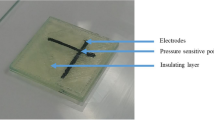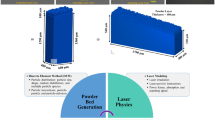Abstract
This paper presents a hybrid additive manufacturing (AM) process combining multilayer friction surfacing (FS) and metal machining operations. While friction surfacing has been known as a part repair or coating process, we here present an attempt to use it to build whole 3D metallic parts. The feasibility of the process is tested using heat-treatable Aluminum alloy AA6061 rod on a mild steel substrate. A series of FS experiments was conducted with the purpose to identify suitable process settings. This included different combinations of rotational and travel speeds of the FS rod. Quality of deposited layers was assessed using different indicators including bond width, layer uniformity, layer thickness, and others. ANOVA was conducted to reveal the effects of process parameter settings on the quality metrics. Two metallic parts were printed successfully, which demonstrates the feasibility of the proposed hybrid process.










Similar content being viewed by others
Change history
19 June 2021
A Correction to this paper has been published: https://doi.org/10.1007/s40964-021-00202-5
References
Abdulhameed O, Al-Ahmari A, Ameen W, Mian SH (2019) Additive manufacturing: challenges, trends, and applications. Adv Mech Eng. https://doi.org/10.1177/1687814018822880
Khoo ZX et al (2015) 3D printing of smart materials: a review on recent progresses in 4D printing. Virtual Phys Prototyp 10(3):103–122. https://doi.org/10.1080/17452759.2015.1097054
Pragana JPM et al (2021) Hybrid metal additive manufacturing: a state-of-the-art review. Adv Ind Manuf Eng 100032
Gong X et al (2018) Arc welding processes for additive manufacturing: a review. Manuf Rev. https://doi.org/10.1007/978-981-10-5355-9_1
Yan Z et al (2018) Review on thermal analysis in laser-based additive manufacturing. Opt Laser Technol 106:427–441. https://doi.org/10.1016/j.optlastec.2018.04.034
Pan Z, Ding D, Wu B, Cuiuri D, Li H, Norrish J (2018) Arc welding processes for additive manufacturing: a review. Transactions on intelligent welding manufacturing, pp 3–24
Yakout M, Elbestawi MA, Veldhuis SC (2018) A review of metal additive manufacturing technologies. Solid State Phenomena, vol 278. pp 1–14. https://doi.org/10.4028/www.scientific.net/SSP.278.1
Joe Hiemenz (2014) Additive manufacturing trends in aerospace. Stratasys. p 1–11. www.stratasys.com
Srivastava M, Rathee S, Maheshwari S, NoorSiddiquee A, Kundra TK (2019) A review on recent progress in solid state friction based metal additive manufacturing: friction stir additive techniques. Critical Rev Solid State Materials Sci. https://doi.org/10.1080/10408436.2018.1490250
Sahasrabudhe H, Bose S, Bandyopadhyay A (2018) Laser-based additive manufacturing processes. Advances in Laser Materials Processing, pp 507–539
Gong X , Anderson T, Chou K (2012) Review on powder-based electron beam additive manufacturing Technology. International Symposium on Flexible Automation, vol 45110, pp 507–515. https://doi.org/10.1051/mfreview/2014001
Ding D et al (2016) Towards an automated robotic arc-welding-based additive manufacturing system from CAD to finished part. CAD Comput Aided Des 73:66–75. https://doi.org/10.1016/j.cad.2015.12.003
Williams SW, Martina F, Addison AC, Ding J, Pardal G, Colegrove P (2016) Wire + Arc additive manufacturing. Mater Sci Technol (United Kingdom) 32(7):641–647. https://doi.org/10.1179/1743284715Y.0000000073
Frank M, Joshi SB, Wysk RA (2002) CNC-RP: a technique for using CNC machining as a rapid prototyping tool in product/process development. IIE Annu Conf Proc Inst Ind Eng 1
Altıparmak SC et al (2020) Challenges in Additive Manufacturing of High-Strength Aluminium Alloys and Current Developments in Hybrid Additive Manufacturing. Int J Light Mater Manuf. https://doi.org/10.1016/j.ijlmm.2020.12.004
Caballero A, Ding J, Ganguly S, Williams S (2019) Wire + arc additive manufacture of 17–4 PH stainless steel: effect of different processing conditions on microstructure, hardness, and tensile strength. J Mater Process Technol 268:54–62. https://doi.org/10.1016/j.jmatprotec.2019.01.007
Das S, Bourell DL, Babu SS (2016) Metallic materials for 3D printing. MRS Bull 41(10):729–741. https://doi.org/10.1557/mrs.2016.217
Colegrove PA, Donoghue J, Martina F, Gu J, Prangnell P, Hönnige J (2017) Application of bulk deformation methods for microstructural and material property improvement and residual stress and distortion control in additively manufactured components. Scr Mater 135:111–118
Takagi H, Sasahara H, Abe T, Sannomiya H, Nishiyama S, Ohta S, Nakamura K (2018) Material-property evaluation of magnesium alloys fabricated using wire-and-arc-based additive manufacturing. Addit Manuf 24:498–507
Wu B, Pan Z, Ding D, Cuiuri D, Li H, Xu J, Norrish J (2018) A review of the wire arc additive manufacturing of metals: properties, defects and quality improvement. J Manuf Process 35:127–139
Abdel-All ES, Frank MC, Rivero IV (2017) Rapid tooling using friction stir welding and machining. Rapid Prototyp J 23(1):81–95. https://doi.org/10.1108/RPJ-08-2015-0107
Friel RJ, Harris RA (2013) Ultrasonic additive manufacturing A hybrid production process for novel functional products. Procedia CIRP 6:35–40. https://doi.org/10.1016/j.procir.2013.03.004
Rathee S et al (2018) Friction deposition-based additive manufacturing techniques. Friction Based Additive Manufacturing Technologies, pp 75–96
Ramkumar P, Vijay SJ, Mohanasundaram S (2019) Novel solid-state metal additive manufacturing technique: experiments and investigations. Int J Mech Eng Technol 10(2):809–816
Dilip JJ, Babu S, Rajan SV, Rafi KH, Ram GJ, Stucker BE (2013) Use of friction surfacing for additive manufacturing. Mater Manuf Process. https://doi.org/10.1080/10426914.2012.677912
Kandasamy K, Renaghan LE, Calvert JR, Creehan KD, Schultz JP (2013) Solid-state additive manufacturing of aluminum and magnesium alloys. Materials Sci Technol Conference Exhibition 1:59–69
Shen J, Hanke S, Roos A, Santos JF, Klusemann B(2019) Fundamental study on additive manufacturing of aluminum alloys by friction surfacing layer deposition. AIP Conference Proceedings, vol 2113. https://doi.org/10.1063/1.5112691
Griffiths RJ, Petersen DT, Garcia D (2019) Yu HZ Additive friction stir-enabled solid-state additive manufacturing for the repair of 7075 aluminum alloy. Appl Sci. https://doi.org/10.3390/app9173486
Gandra J, Pereira D, Miranda RM, Silva RJC, Vilaça P (2013) Deposition of AA6082-T6 over AA2024-T3 by friction surfacing-Mechanical and wear characterization. Surf Coatings Technol 223:32–40. https://doi.org/10.1016/j.surfcoat.2013.02.023
Silvério S, Krohn H, Fitseva V, de Alcântara NG, dos Santos JF (2018) Deposition of AA5083-H112 Over AA2024-T3 by friction surfacing. Soldag e Insp 23(2):225–234. https://doi.org/10.1590/0104-9224/SI2302.09
Raju VP, Hussain MM, Govardhan D (2016) Effect of process parameters on the width of friction surfaced tool steel M2 deposit over low carbon steel. Int J Mater Sci 11(1):1–7
Kumar MV, Satish V (2012) Friction stir surfacing of copper. Int J Sci Res 3(7):2319–7064. www.ijsr.net
RaviSekhar S, Chittaranjandas V, Govardhan D (2018) Evaluation of bond quality and corrosion resistance of stainless steel-low carbon steel friction surfaced deposit. Int J Mech Prod Eng Res Dev. https://doi.org/10.24247/ijmperdjun201852
Sunil BDY, LabeshKumar C (2017) Friction surfacing of stainless steel on low carbon steel for corrosion resistance application-an experimental approach. Int J Mech Prod Eng Res Dev. https://doi.org/10.24247/ijmperdoct201714
RaviSekhar S, Chittaranjandas V, Govardhan D (2017) Friction surfacing process of stainless steel alloys. Int J Mech Eng Technol 8(7):613–626
de Macedoa MLK, Pinheiro GA, dos Santos JF, Strohaecker TR (2010) Deposit by friction surfacing and its applications. Weld Int 24(6):422–431. https://doi.org/10.1080/09507110902844535
Batchelor AW, Jana S, Koh CP, Tan CS (1996) The effect of metal type and multi-layering on friction surfacing. J Mater Process Technol 57(1–2):172–181. https://doi.org/10.1016/0924-0136(95)02057-8
Shinoda T, Li J (1999) Surface modification of 5083 aluminum alloys using friction surfacing. Keikinzoku/Journal Japan Inst Light Met 49(10):499–503. https://doi.org/10.2464/jilm.49.499
Li JQ, Shinoda T (2000) Underwater friction surfacing. Surf Eng 16(1):31–35. https://doi.org/10.1179/026708400322911483
Galvis JC, Oliveira PHF, Hupalo MF, Martins JP, Carvalho ALM (2017) Influence of friction surfacing process parameters to deposit AA6351-T6 over AA5052-H32 using conventional milling machine. J Mater Process Technol 245:91–105. https://doi.org/10.1016/j.jmatprotec.2017.02.016
Vitanov VI, Voutchkov II (2005) Process parameters selection for friction surfacing applications using intelligent decision support. J Mater Process Technol 159(1):27–32. https://doi.org/10.1016/j.jmatprotec.2003.11.006
Da Silva MM, Afonso ML, Silva SL, Troysi FC, dos Santos B, Brito PP (2018) Application of the friction surfacing process in a CNC machining center: a viability assessment for producing Al-alloy coatings on low carbon steel. J Brazilian Soc Mech Sci Eng. https://doi.org/10.1007/s40430-017-0947-x
Galvis JC, Oliveira PH, Martins JD, Carvalho AL (2018) Assessment of process parameters by friction surfacing on the double layer deposition. Mater Res. https://doi.org/10.1590/1980-5373-MR-2018-0051
Seidi E, Miller SF (2019) Friction surfacing using consumable tools: a review. ASME 2019 14th International Manufacturing Science and Engineering Conference, MSEC 2019, vol 2. https://doi.org/10.1115/MSEC2019-2963
ASM Material Data Sheet. http://asm.matweb.com/search/SpecificMaterial.asp?bassnum=MA6061T6
Funding
This research was funded by Deanship of Research at Jordan University of Science and Technology, Grant No.20190036.
Author information
Authors and Affiliations
Corresponding author
Ethics declarations
Conflict of interests
On behalf of all authors, the corresponding author declares that there is no conflict of interest.
Additional information
Publisher's Note
Springer Nature remains neutral with regard to jurisdictional claims in published maps and institutional affiliations.
The original online version of this article was revised: figure 10 was not correct.
Rights and permissions
About this article
Cite this article
Abdelall, E.S., Al-Dwairi, A.F., Al-Raba’a, S.M. et al. Printing functional metallic 3D parts using a hybrid friction-surfacing additive manufacturing process. Prog Addit Manuf 6, 731–741 (2021). https://doi.org/10.1007/s40964-021-00193-3
Received:
Accepted:
Published:
Issue Date:
DOI: https://doi.org/10.1007/s40964-021-00193-3




